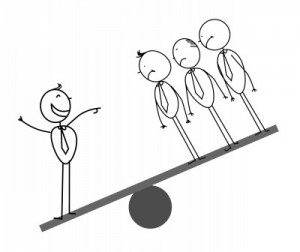Is there a “difficult” employee causing trouble under your watch?
What if this employee also happens to be very talented? When a leader must decide what to do about a technically skilled, yet socially difficult employee, here is what Ron McMillan, co-author of the book Crucial Conversations says in a recent newsletter from Vital Smarts:
“Responsible leaders care about their people – the one and the many. They don’t callously fire individuals, nor do they allow a single employee to disrespect, abuse, or negatively impact others. They don’t demand change without helping people have the means to change and reasonable time to do it. Responsible leaders give actionable feedback and recognize progress. And they follow through.”
- As a leader, are you balancing the needs of the one & the many?
Ron is spot-on! When you are a leader, you are constantly balancing the demands of the “one” with “the many”. There are so many leadership “balancing acts”:
– You supervise a brilliant employee who is disdainful of anybody he perceives as intellectually inferior
– You lead a project in which one of the team members is overloaded and vents her frustration by verbally attacking other team members
– You are working extensively with an employee who is struggling at work; you wonder if you are short-changing other team members in the process
All of these scenarios require you to think compassionately about the individual in question and about the many people with whom this person interacts. Leadership requires motion and balance – just like riding a see-saw.
Food for thought: are there any areas of your professional life in which the leadership see-saw may be tipped too heavily in favor of either side?
Image credit: redrockerz / 123RF Stock Photo
Disclosure: some of the links in this post are affiliate links, meaning if you click on the link and make a purchase, I will get a commission. Hey a girl’s gotta pay for her blogging habit somehow, right?

“All of these scenarios require you to think compassionately about the individual in question and about the many people with whom this person interacts.”
Compassionate leadership IS a challenge, especially with difficult people. One manager might favor the troublemaker’s talents and ignore his disruptive behavior; another might have no tolerance for the behavior and decide to discipline him or fire him. Can a person change under guidance? Perhaps. One hates to lose a talented worker, but then, a good team will have many talented people who may be suffering because of this person.